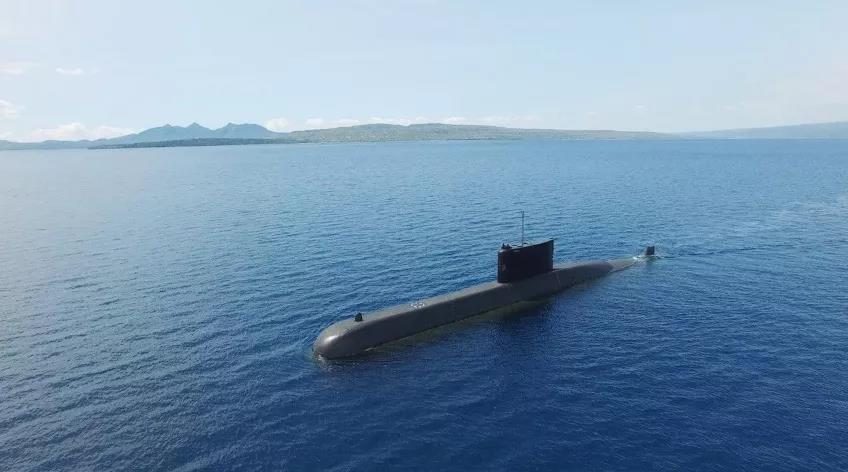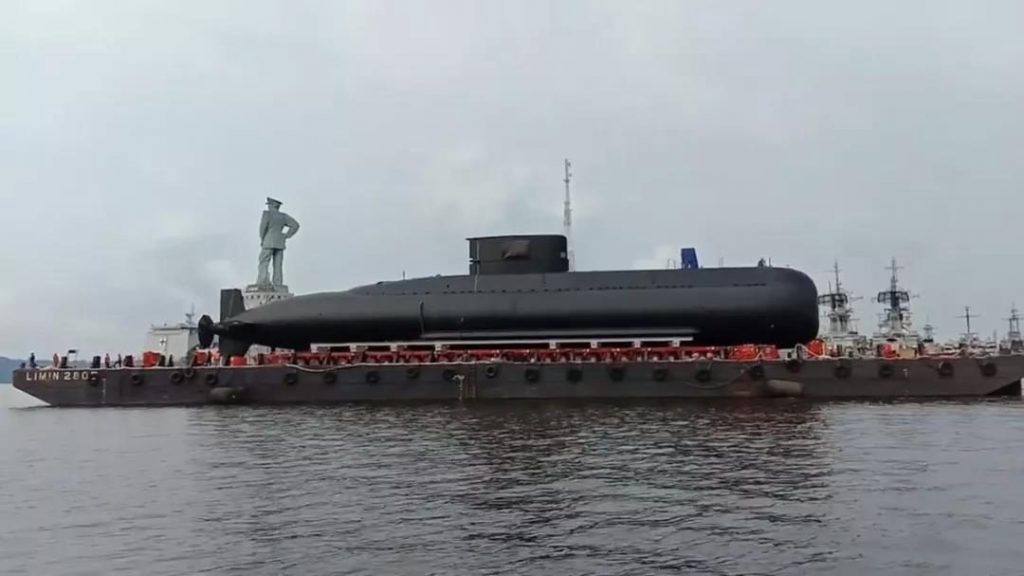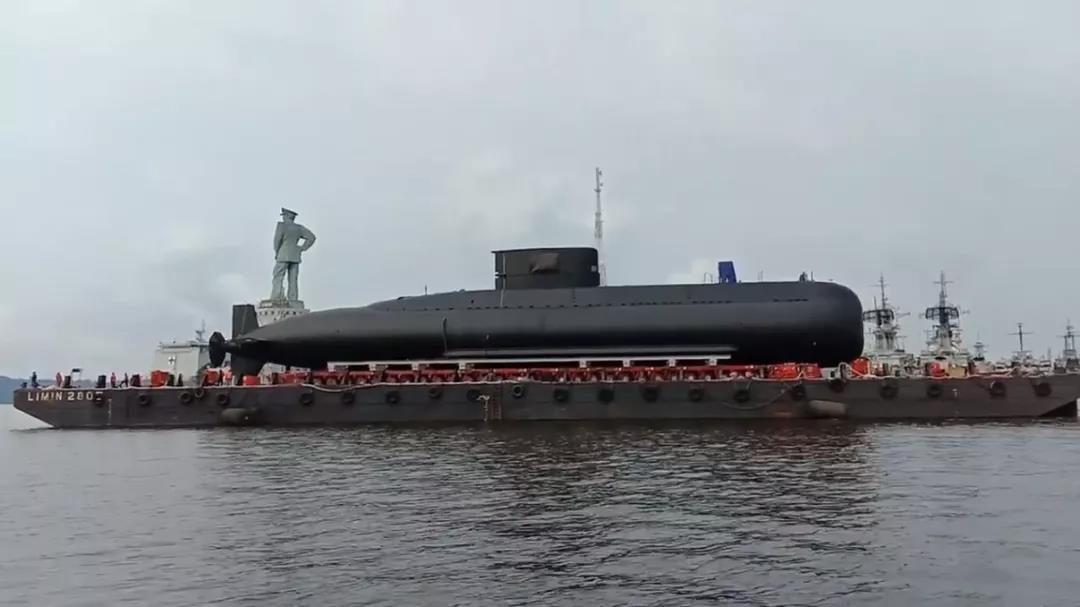The missing Indonesian navy submarine Nanggala may have sunk in a trench about 700 metres deep, exceeding the submarine’s maximum dive depth.
On April 21st, local time, an Indonesian navy submarine named Nangara disappeared while training.
An Indonesian navy spokesman said Tuesday that a submarine went missing while training for torpedoes in waters north of Bali, Reuters reported.
Hadi Jajanto, commander of the Indonesian National Army, said the missing submarine may have sunk to a depth of about 700 meters, and the Indonesian military has sent several warships to search the area.
In November 2017, the Argentine submarine San Juan went missing, and after a search, the wreckage of the submarine was found at a depth of 800 meters, killing all 44 crew members. Coincidentally, the Indonesian Navy’s Nangara submarine is the same type of type 209 as the San Juan, both made in Germany.
The usS Nangara, which sails on the surface of the water.
Missing Indonesian submarine: 40 years in service, midway through South Korea upgrade
An Indonesian navy spokesman said the German-made Nangara submarine was conducting torpedo launch exercises in waters north of Bali, but failed to provide timely feedback to the command center.
“We are still searching for 53 people on board the submarine near the sea 60 miles (96 kilometers) from Bali,” Mr Hadi Jajanto said. The official confirmed that the military had sought assistance from Australia and Singapore in the search for the submarine and its missing crew. He said the connection with the submarine was at 4:30 a.m. on the 21st.
According to the website of the Indonesian Cabinet Secretariat, the “Nangara” belongs to the “Kakla”-class submarine, with an underwater displacement of 1395 tons and a number 402, which was built in Germany in 1978 and entered service in 1981.
“Kakla”-class submarines can carry out anti-submarine, anti-ship, mine and reconnaissance missions, the main tasks are inshore patrol and surveillance, but also to carry out ocean patrol operations. The submarine has a maximum depth of 280 metres and is equipped with eight 533 mm torpedo tubes carrying 14 torpedoes.
The Kakla class was upgraded in South Korea, where the Nangara underwent a two-year modification in 2011 and completed in 2012, further enhancing its operational capabilities. The Nangara has been in service for 40 years, and although it was upgraded midway through, the hull is still relatively old.
“There are four main reasons for the submarine sinking: first, the explosion of batteries, second, torpedoes, anti-ship missiles and other ship-borne weapons exploded; third, encountered the ‘sea floor cliff’ (sea leap layer), the phenomenon of deep fall, and fourth, underwater impact,” Shi Hong, deputy editor of ship-borne weapons magazine, told the www.thepaper.cn. ”
“At present, according to the Indonesian military, the preliminary judgment of the submarine may have sunk, so the first step in the rescue work is to find the specific location of the submarine sinking, using warships, submarines, anti-submarine aircraft using sonar or submarine search,” Shi Hong pointed out, “because the submarine oxygen is limited, it is necessary to find the submarine as soon as possible.” ”
Shi Hong said that the main work after finding the exact location of the submarine is to carry out the submarine external rescue: first, to understand the damage;
According to the paper, specialized underwater rescue devices include life-saving clocks and manned deep-dive lifeboats. The life-saving clock, also known as the diving clock, was first born in the 1930s. The life-saving clock itself has no power and relies on the mother ship winch to be hoisted to the landing port of the wrecked submarine and docked with the help of divers. The manned deep dive lifeboat is a dynamic artificial operation submersible device, the docking time is shorter, and equipped with sonar, flash, thermometer and other more perfect underwater search and rescue equipment, is the most advanced underwater rescue device.
“The biggest problem now is Indonesia’s lack of submarine rescue forces, the need for help from neighbouring Singapore and Australia, the time it takes for these rescue vessels to reach the sunken waters, and the limited oxygen, and if the submarine sinks at a depth of 700 metres, it is more than the submarine’s maximum dive depth, the pressure-resistant shell ruptures, and the crew can be said to be less ferocious.” Shi Hong said.

Indonesia has purchased several South Korean submarines, which are growing in strength.
Behind the submarine’s disappearance: Indonesia wants to be Southeast Asia’s submarine power “one brother”
On March 17, local time, the Indonesian state-owned enterprise PT PAL held an official service ceremony for the Indonesian Navy-built submarine Alugoju. Number 405 is Indonesia’s first domestically produced military submarine, and the first domestic submarine in Southeast Asian countries.
Indonesia’s defense chief, Prabowo Subianto, said in a speech that Indonesia’s autonomous defense industry capabilities have been greatly enhanced.
The name “Arugo” is derived from a sacred weapon by the traditional Indonesian dramatist Prabhu Baladwa, which is similar to the wolf-toothed stick used by knights and can knock down opponents with a click.
The construction of the Arugoju, the third Nagapasa-class submarine to be built by Daewoo Shipbuilding and Marine Engineering Corporation (DSME), is based on the South Korean “Zhang Baoyu” class submarine (German 209/1400 submarine), which has been adapted to the needs of the Indonesian navy. The first boats, the Nagabasas and the 2nd, the Adaddari, will be delivered in 2017 and 2018, respectively.
According to data released by the Indonesian military, the Alugojuan has a displacement of 1,400 tons, a length of 61.3 meters, an underwater speed of 21 knots, 40 crew members and 50 days of self-reliance at sea. The submarine is equipped with eight 533 mm torpedo launch tubes that can fire torpedoes, anti-ship missiles and deploy mines, as well as special forces to carry out special operations missions in coastal areas.
Shortly after the Alugota entered into the water in April 2019, The Indonesian side signed an agreement with Daewoo to acquire three additional improved Nagapasa-class submarines with a contract value of approximately $1.02 billion.

Indonesia’s first home-made submarine, the Alugoju.
If the Nangara does not sink and completes the construction of three improved Nagapasa-class submarines, plus three active Nagapasa-class submarines (contracted in 2011) and two active Kakla-class submarines, the Indonesian Navy will acquire the first submarine fleet in Southeast Asia. Even excluding the Nangara, the Indonesian navy will have seven medium-sized submarines by around 2025, more than Vietnam, which has six. More importantly, by stepping into the construction of the 209/1400 submarines, Indonesia will begin to master certain submarine-building techniques.
During the Cold War, Indonesia was once the most powerful submarine country in Southeast Asia, once with an underwater force of 12 Soviet submarines patrolling the waters of its vast archipelago.
Indonesia is ambitious, but there are concerns about its growing underwater power. Reuters reported that Indonesia has been seeking to upgrade its defense capabilities, but some of the ships still in service are old and have suffered several fatal accidents in recent years, particularly involving older military transport aircraft.
“Indonesia’s efforts to build underwater power, but ignored the construction of submarine rescue forces, in the event of a crash, can only turn to other countries, which is not a good thing for the race for time submarine rescue work, and submarine rescue force construction will cost a lot of money, which is a limited funding for Indonesia is another difficult thing.” Shi Hong pointed out.
“Southeast Asian countries have been increasingly competing for submarines in recent years, buying new or second-hand submarines at great expense, and have not considered building submarine underwater rescue forces, except in Singapore.” Shi Hong said. (Intern Geng Xiang contributed to this article)



